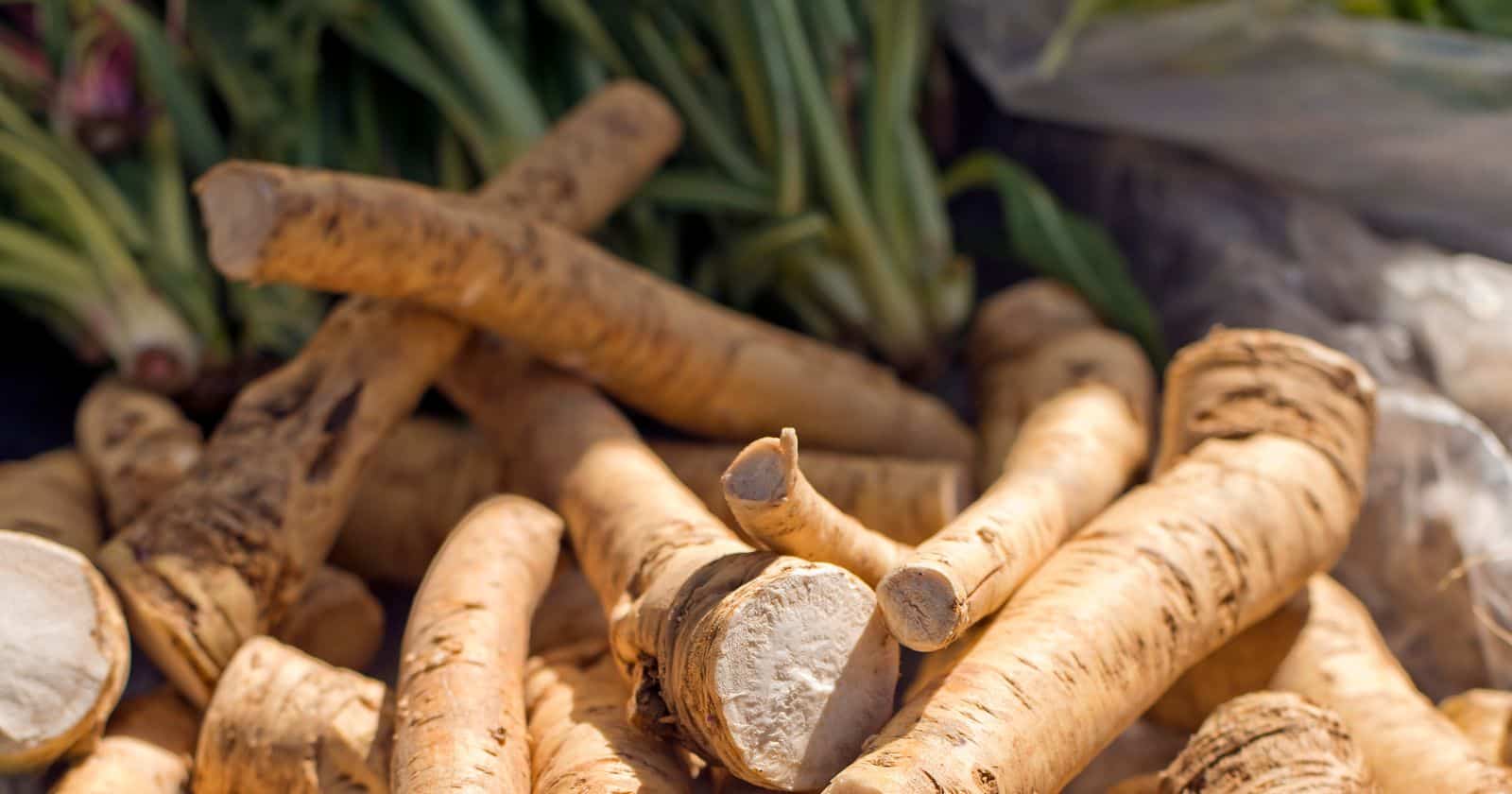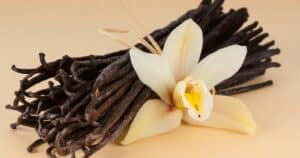Do you want to add a bold and fiery kick to your meals? Are you tired of using the same old spices on your dishes?
Look no further than horseradish! This root vegetable adds a unique flavor and aroma to any food, from roast beef to sauces.
Horseradish belongs to the Brassicaceae family and is closely related to mustard and wasabi. It can be found fresh, dried, or in sauce form and has several health benefits due to its high nutrient content.
So get ready to
The History and Cultivation of Horseradish
Horseradish has been around for centuries, and its cultivation and use have a fascinating history. The root vegetable is a perennial and has been used worldwide as a
In Egypt, it was known as early as 1500 BCE. Horseradish was used in Passover Seders by Jews from Eastern Europe.
The Greeks used it as a lower back rub and an aphrodisiac, while Europeans, especially in Central Europe, started using it by the 1300s-1600s.
Horseradish was brought to North America by early settlers, and commercial cultivation began in the mid-1850s when immigrants started horseradish farms in the Midwest.
The root is still grown in the same areas in the Midwest, notably Illinois, and Wisconsin, with further cultivation in other parts of the United States, Europe, and Asia.
The cultivation of horseradish is a delicate process that requires attention and care. The soil must be moist but not too wet to grow healthy roots. The plant prefers colder climates and can be grown successfully in areas with heavy, moist soil. The seeds can be harvested yearly, but the process must be done carefully, as the root system is fragile.
Harvesting horseradish is a labor-intensive process. The roots are dug up, and the leaves and stems are cut off, leaving only the core. The heart is then washed, grated, and mixed with vinegar to make a spicy sauce. The grated horseradish is then packed and sold in jars or bottles.
Horseradish has a pungent flavor and is often used as a condiment for sandwiches, meats, and other dishes. It also makes sauces and dips, such as cocktail sauce and horseradish cream sauce. In addition, horseradish has medicinal properties and has been used to treat colds, coughs, and respiratory infections.
Types of Horseradish: Fresh, Dried, and Sauce Form
Types of Horseradish: Fresh, Dried, and Sauce Form. Horseradish comes in different forms, each with its own unique flavor and texture.
Fresh horseradish is grated from the root and mixed with vinegar, creating a tangy and pungent taste.
On the other hand, dried horseradish is made by dehydrating the grated meat and grinding it into a powder. This form has a more concentrated flavor and can be used as a seasoning.
Finally, horseradish sauce is made by blending grated horseradish with mayonnaise, sour cream, or mustard, creating a creamy texture and is perfect as a dip or spread.
Regarding nutritional content, horseradish is rich in vitamin C, fiber, and potassium. Moreover, the plant also contains a compound called sinigrin, which is responsible for its signature pungent flavor and has shown potential cancer-fighting properties.
When using horseradish in recipes, pairing it with complementary flavors is essential. For example, fresh horseradish’s potent, spicy flavor pairs well with meaty dishes like beef or steak sauces and seafood dishes like smoked salmon or shrimp cocktails.
Dried and powdered horseradish are great additions to rubs and marinades for meat dishes, adding an extra layer of flavor.
Meanwhile, horseradish sauce is a versatile condiment that can add a kick to sandwiches, deviled eggs, or roasted vegetables.
Horseradish Uses in Cooking: From Roast Beef to Sauces
Horseradish is a powerhouse ingredient in the world of cooking. It’s versatile and can add a deliciously spicy kick to various dishes. One of the most classic uses of horseradish in cooking is as a condiment for roast beef, steak, and prime rib. But that’s not all it’s suitable for. Here are some other ways horseradish can be used in the kitchen:
- Creamy horseradish sauce: This deliciously creamy sauce is perfect for beef tenderloin, steak, or prime rib. Combine sour cream, prepared horseradish, dijon mustard, champagne vinegar, and other ingredients to create a sauce that rivals the best steakhouse horseradish.
- Crusted beef: Horseradish can create a delicious crust for meat. Just mix horseradish, breadcrumbs, and herbs to make a topping for your roast beef or steak.
- Pickles: Horseradish pickles are a great accompaniment to your favorite sandwiches. You can make your pickles or add horseradish to your favorite store-bought pickles.
Health Benefits of Horseradish: Anti-Inflammatory and Antioxidant Properties
Horseradish is packed with antioxidants and anti-inflammatory properties that benefit our health in various ways. Its bioactive compounds have natural cancer-fighting properties that protect the body from cellular damage caused by free radicals. Here are some of the health benefits of horseradish:
- Anti-inflammatory: Horseradish contains anti-inflammatory properties that lower inflammation in the body. It’s effective in treating respiratory inflammation, asthma, and bronchitis. Additionally, it can be used as an herbal remedy to treat arthritis and joint pain.
- Antioxidant: Horseradish has potent antioxidant properties that protect the body from oxidative stress, which causes cellular damage. Antioxidants in horseradish help neutralize free radicals, thereby preventing cell damage that causes aging, cancer, and other chronic diseases.
- Wound Healing: Horseradish can be used topically to heal wounds and injuries. The antibacterial properties of horseradish help prevent infection and facilitate wound healing.
- Weight loss: Horseradish is low in calories and packed with essential nutrients, making it a great weight loss aid. It promotes satiety and curbs hunger, helping you maintain a healthy weight.
How to Store and Prepare Horseradish: Tips and Tricks
Horseradish lovers know the importance of storing horseradish properly to minimize wastage and maintain its unique flavor. To reserve this root vegetable, keep it in a plastic bag and store it in the refrigerator’s vegetable drawer at 32 to 40°F.
If the root is cut, it will only last for about two weeks. One other alternative is storing horseradish in a cold root cellar. You can bundle the seeds, store them in damp sand, and protect them from light exposure to enhance their shelf life.
Preparing horseradish requires washing and peeling the root before grating it. Freshly ground horseradish tends to be more pungent than the prepared one you purchase from a jar at your local store. Mix grated horseradish with vinegar or lemon juice to enhance its flavor and keep it fresh.
By following these simple tips, you can prepare and store horseradish in a way that maintains its unique taste.
When you’re ready to get creative with horseradish, you can freeze it by spooning out dabs of grated horseradish onto a baking sheet lined with plastic wrap or into plastic ice cube trays. Once frozen, transfer the cubes into a storage container and take them out as desired.
You can also mix horseradish with other ingredients, such as cream or mustard, to create unique flavor combinations that satisfy your taste buds.
Horseradish Substitute
There are plenty of options if you’re looking for a substitute for horseradish! First, wasabi, mustard, ginger, black radish, daikon, and sauerkraut make great substitutes. But let’s dive deeper into why these ingredients work so well.
- Wasabi: This spicy paste is often served with sushi and has a similar heat and nose-tingling effect as horseradish. Wasabi paste can be found in most grocery stores and online and used in recipes instead of horseradish.
- Mustard: Both mustard and horseradish are pungent and spicy, making mustard a great recipe substitute. Dijon, yellow, or spicy brown mustard can all be used as a substitute for horseradish.
- Ginger: This spicy root is commonly used in Asian cuisine and has a similar heat as horseradish. Fresh ginger can be grated or chopped and added to recipes instead of horseradish.
- Black Radish: With its white flesh and black skin, this root looks similar to horseradish and has a similar flavor profile. Black radish can be grated and used in recipes in place of horseradish.
- Daikon: Similar to black radish, daikon is a long white radish with a mild, spicy flavor. It can be grated and used as a substitute for horseradish.
- Sauerkraut: This fermented cabbage dish has a tangy and slightly spicy flavor that can be used as a substitute for horseradish. Sauerkraut can be added to sandwiches, salads, or even blended into a dressing.
No matter which substitute you choose, you can still achieve a similar flavor profile as horseradish in your recipes. So don’t let a lack of horseradish stop you from trying new recipes!





